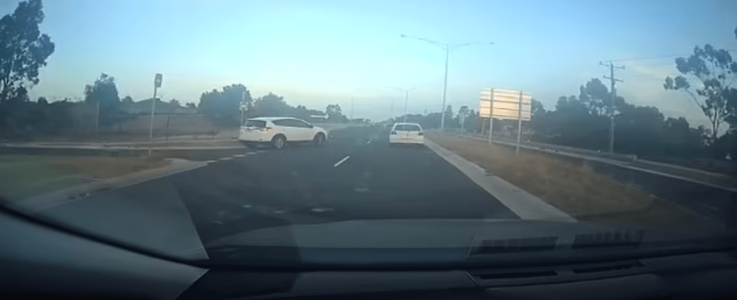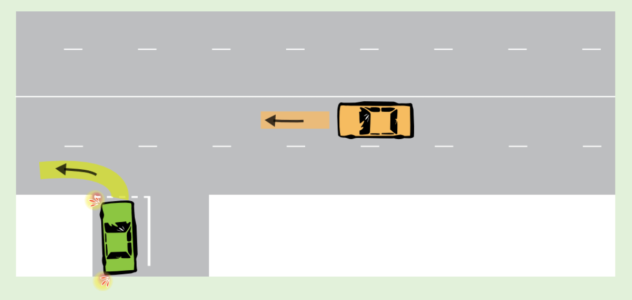Common traffic situation sparks heated debate around road rules - what would YOU do?
- Replies 3
For both infrequent drivers and those driving every day - navigating the roads can be a real challenge.
It takes more than just steering and stepping on the pedal; you need to have a thorough understanding of the road rules and regulations to keep yourself and other drivers safe.
But even the most seasoned drivers can find themselves in sticky situations where they're not entirely sure what to do.
In those moments, the most critical thing is to keep a cool head, exercise caution, and prioritise safety above all else. Because in a split second, the wrong move can have dire consequences.

Take, for instance, a recent incident that made waves on social media. A Melbourne motorist posted a dash cam video showing a white SUV entering the left lane of a major road from a side street, while a Honda HR-V was driving in the right lane.
The user who posted wrote in the caption: 'Entering the traffic stream - Does the car entering the road only have to give way to cars in the lane they are entering, or all lanes? I got a bit of a fright when they decided to enter the road whilst approaching in the right lane.'
It might seem like a simple case of right of way, but the responses to the post were anything but straightforward. People had different opinions, and the discussion sparked a flurry of comments.
Online commenters argued that the safest bet was to wait until all lanes were clear - or at least wait to make sure other motorists were not indicating or planning to move into the same lane.
'I'm not sure of the exact law, but I've always felt that it's a risky thing to do going out in that situation as you never know what the others are thinking and that they might just change lanes at any moment,' said one user.
Another shared a personal experience, saying: 'During my first driving lesson, I did that and got in trouble with my instructor. They told me to leave two lanes clear. From a safety point of view, you do not know whether someone is going to change to the left lane or not.'
A third user agreed and added, 'I don't know if that's the actual law, but it's a good idea either way, especially if you're in a longer car that has a wider turning circle.'

Not everyone agreed that the white SUV had done anything wrong. Some commenters pointed out that the driver had made a perfectly legal move and had taken the necessary precautions.
One person argued that as long as no cars were in the way, and no other vehicle in the next lane was indicating to move into the lane, the manoeuvre was perfectly legal. However, they also acknowledged that exercising some caution was still warranted.
Another commenter chimed in, pointing out that the white SUV driver had assessed the traffic and made a visible, deliberate move. They also noted that there was plenty of time and visibility for the Honda HR-V driver to see the SUV entering the lane, and they should have already assessed the situation.
What does the law say?
VicRoads Driving Instructors Drive test book says drivers entering a two-lane intersection in this situation are not in the wrong if the nearest car in the left lane is at least 200 metres away.
If the nearest vehicle is in the right lane 20 metres away, and not indicating to turn into the left lane, then it is OK for a tester to enter the roadway.

Here's the scenario given in the test book:
The applicant faces a Give Way sign at a T-intersection and is waiting to turn left into a road with two lanes in each direction. In the left lane of the intersecting road (the lane closest to the applicant), the nearest approaching vehicle from the left is 200 metres away.
In the right lane of the intersecting road, the nearest approaching vehicle from the right is only 20 metres away and is not signalling an intention to change lanes. The applicant turns left into the left-most lane of the intersecting road without encroaching into the right lane.
And here's the assessment:
Since the applicant does not encroach into the lane occupied by the nearest approaching vehicle (and that vehicle was not signalling an intention to move into the lane into which the applicant turned), no failure to give way has occurred. No error should be recorded.
The debate on the dash cam video underscores the importance of having a solid understanding of road rules and regulations. But it also highlights the nuances and complexities that come with navigating real-world traffic situations.
The truth is, the answer is not always black and white. Sometimes, it takes a bit of interpretation and context to understand what the rules dictate. Whether you're an infrequent driver or a seasoned pro, it's crucial to exercise caution, prioritise safety, and use good judgement when behind the wheel.

We hope this article has shed some light on the complexities of navigating Australia's roads and the importance of exercising caution and good judgement while driving. As always, we would love to hear from you.
Did you find this case confusing, or were you confident in your assessment of the situation? What would you have done in the same scenario? Share your thoughts and experiences in the comments section below!
It takes more than just steering and stepping on the pedal; you need to have a thorough understanding of the road rules and regulations to keep yourself and other drivers safe.
But even the most seasoned drivers can find themselves in sticky situations where they're not entirely sure what to do.
In those moments, the most critical thing is to keep a cool head, exercise caution, and prioritise safety above all else. Because in a split second, the wrong move can have dire consequences.

With so many rules and regulations to remember, it isn't always easy to know the correct thing to do in certain situations. Credit: Unsplash/Joshua Leong.
Take, for instance, a recent incident that made waves on social media. A Melbourne motorist posted a dash cam video showing a white SUV entering the left lane of a major road from a side street, while a Honda HR-V was driving in the right lane.
The user who posted wrote in the caption: 'Entering the traffic stream - Does the car entering the road only have to give way to cars in the lane they are entering, or all lanes? I got a bit of a fright when they decided to enter the road whilst approaching in the right lane.'
It might seem like a simple case of right of way, but the responses to the post were anything but straightforward. People had different opinions, and the discussion sparked a flurry of comments.
Online commenters argued that the safest bet was to wait until all lanes were clear - or at least wait to make sure other motorists were not indicating or planning to move into the same lane.
'I'm not sure of the exact law, but I've always felt that it's a risky thing to do going out in that situation as you never know what the others are thinking and that they might just change lanes at any moment,' said one user.
Another shared a personal experience, saying: 'During my first driving lesson, I did that and got in trouble with my instructor. They told me to leave two lanes clear. From a safety point of view, you do not know whether someone is going to change to the left lane or not.'
A third user agreed and added, 'I don't know if that's the actual law, but it's a good idea either way, especially if you're in a longer car that has a wider turning circle.'

The dash cam footage showed a Honda HR-V entering the left-hand lane of a multi-lane street while the driver of the filming car was driving in the right-hand lane. Credit: Reddit.
Not everyone agreed that the white SUV had done anything wrong. Some commenters pointed out that the driver had made a perfectly legal move and had taken the necessary precautions.
One person argued that as long as no cars were in the way, and no other vehicle in the next lane was indicating to move into the lane, the manoeuvre was perfectly legal. However, they also acknowledged that exercising some caution was still warranted.
Another commenter chimed in, pointing out that the white SUV driver had assessed the traffic and made a visible, deliberate move. They also noted that there was plenty of time and visibility for the Honda HR-V driver to see the SUV entering the lane, and they should have already assessed the situation.
What does the law say?
VicRoads Driving Instructors Drive test book says drivers entering a two-lane intersection in this situation are not in the wrong if the nearest car in the left lane is at least 200 metres away.
If the nearest vehicle is in the right lane 20 metres away, and not indicating to turn into the left lane, then it is OK for a tester to enter the roadway.

While it is permissible to enter the roadway, motorists should be mindful not to encroach into the right lane. Credit: VicRoads.
Here's the scenario given in the test book:
The applicant faces a Give Way sign at a T-intersection and is waiting to turn left into a road with two lanes in each direction. In the left lane of the intersecting road (the lane closest to the applicant), the nearest approaching vehicle from the left is 200 metres away.
In the right lane of the intersecting road, the nearest approaching vehicle from the right is only 20 metres away and is not signalling an intention to change lanes. The applicant turns left into the left-most lane of the intersecting road without encroaching into the right lane.
And here's the assessment:
Since the applicant does not encroach into the lane occupied by the nearest approaching vehicle (and that vehicle was not signalling an intention to move into the lane into which the applicant turned), no failure to give way has occurred. No error should be recorded.
The debate on the dash cam video underscores the importance of having a solid understanding of road rules and regulations. But it also highlights the nuances and complexities that come with navigating real-world traffic situations.
The truth is, the answer is not always black and white. Sometimes, it takes a bit of interpretation and context to understand what the rules dictate. Whether you're an infrequent driver or a seasoned pro, it's crucial to exercise caution, prioritise safety, and use good judgement when behind the wheel.

Make sure you brush up on your road rules so you can make informed decisions while driving. Credit: Unsplash/Rolando Garrido.
We hope this article has shed some light on the complexities of navigating Australia's roads and the importance of exercising caution and good judgement while driving. As always, we would love to hear from you.
Did you find this case confusing, or were you confident in your assessment of the situation? What would you have done in the same scenario? Share your thoughts and experiences in the comments section below!







